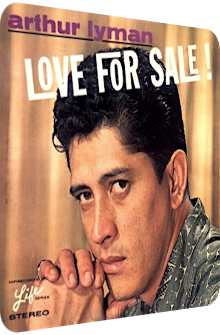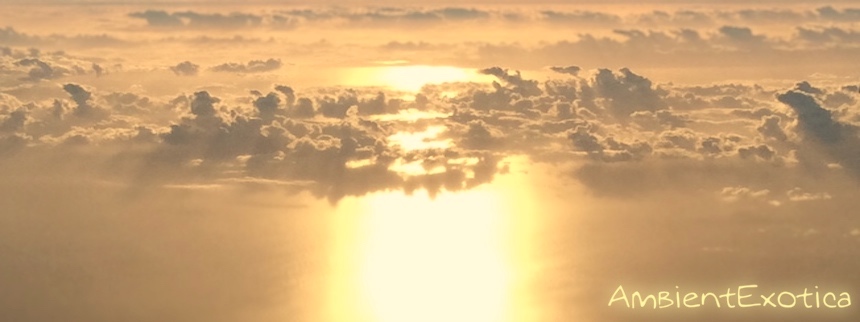
Arthur Lyman
Love For Sale
1963
Lilt: warmhearted tone sequences
The 60’s were the decade where popular music finally broke through and commercialism was firmly established. It was the best of times and it was the worst of times. For Exotica fans, the times worsened as the genre was on its way to the emergency exit by the middle of the 60’s, with the tiki craze only manifesting itself as ever in themed restaurants and bars all over the United States. Then again, these times have been great indeed, especially so in retrospect when one is sitting in his abode, checking out the luxurious and oddball releases of that decade, the skilled works of Jazz combos, the colorful front artworks of the classics… and then along comes Love For Sale! by vibraphonist Arthur Lyman (1932–2002) and his men. Released in 1963 on his house label HiFi Records where it also appeared under the name I Wish You Love, the twelve-track spanning work cuts through the rose-tinted nostalgia against all odds: while its table of contents reveals 12 classics of romantic notion, the front artwork – albeit compatible with the topic – promises things that fans of Exotica usually locate or fear in Hapa Haole records: ukuleles, vocals and then some. Luckily, things are quite different here. Arthur Lyman made it to the front artwork because his rising success and prominence urged HiFi Records to place him there, that’s true enough, but Love For Sale! marks a return to form and is strikingly exotic, more dreamy, less cheesy. With bassist and guitarist John Kramer, percussionist Harold Chang and pianist Alan Soares still running strong, they amend the idea of romanticism and thus bend the style to make it useful to the Exotica fan’s needs. Here, then, is a closer look at some of the album’s important markers.
Love: Exotica had it all along
It has to be said as soon as possible in the wake of the front artwork and the former Exotica craze turning into a fluvial fad by the mid of the 60’s: Love For Sale! is an Exotica LP, an unexpectedly clear-cut one, and for all the good reasons. These reasons may only manifest themselves transparently on a per-song basis, there’s no denial, but their timbrical or aesthetic quality reaches out to all the other sparklers in close proximity. Let’s start with the showstopper of the album in this regard, the exotic tunnel vision called Love. Envisioned by Hugh Martin and Ralph Blane, Lyman’s men make this euphonious ditty an euphoric one: Harold Chang’s smoking fast bongo aorta and its pulsatile reverberation, Alan Soares’ piano that is agglutinated to Arthur Lyman’s punctilio and John Kramer’s bass frame make this the heart of the jungle, a tropical topiary in technicolor. Meanwhile, Paul Francis Webster’s and Sammy Fain’s Love Is A Many Splendored Thing showcases the dreamier side of the genre, with a much mellower, almost pectiniform mirage of soothing vibe nebulae and magenta hues. Quite a bit similar to Lyman’s classic Hawaiian Sunset (1959), the song’s undercurrent is the actual exotic constituent, namely Soares’ celesta which brings a pentatonic, faux-Asian flavor and rhythm-shifting trade wind to the scenery. Finally, the endpoint It’s So Right To Love is written by Lyman himself, a piano-centric tune against all odds, but with hollow and echoey boo-bams bringing in the cerulean hue of the rain forest.
Lyman: In the epicenter
No surprise, the vast majority of love songs in general and the oft-cited bundle of classics that serve as Exotica’s heritage are tremendously catchy, with strong melodies as the all-encompassing helix running through their nucleus. A reason for this – except for the tantamount foundation called talent – is the piano, the launchpad and first device to go to in order to create beautifully diaphanous melodies that are to be arranged in multitude forms, mostly by orchestras, but more often than not by Jazz combos as well. When Arthur Lyman now hammers in this lesson, he does so with his signature mallet instrument, but the result is the same: he is automatically in the limelight and now makes Alan Soares’ piano become the backing device a lot of times. Cy Coleman’s title-lending Love For Sale sports a cautiously Rock-oriented accompaniment based on the piano, powered by Lyman’s diaphanous-polyphonous beams of sunrise mica. Likewise, Paul Francis Webster’s and Sammy Fain’s second offering Secret Love make sure that the glissando-fied veil of helictites glistens in rose-tinted colors; even when its afterglow diffuses, it overlays the plinking piano sparks and the areas behind the proscenium. With the focus on the topic of love, an exotic arrangement doesn’t need to happen at all costs, that’s why the focus on the vibraphone increases, and with it comes the retinue of melodic suprematism.
Lucency: the auroral magnetotail
With the vibraphone as the principal signature instrument comes the lucency, the molybdenized metallic shimmer, the hapticity each part the mallet hits. However, there’s also elasticity involved, with slower tunes allowing the vibe to phase out, ooze through the speakers, ameliorating the air with a milquetoast micrometry that caters to both the follower of love songs and friend of exotic lore. I Wish You Love is a prime example in terms of the soothing hue. Written by Albert Beach and Charles Trenet, this is the ultimate love song arrangement-wise. While it starts with an – admittedly tacky – mouth organ, an instrument that incidentally reappears from time to time as the album progresses, the incisive precision of the bucolic device soon wanes and makes room for alkaliphilic cloudlets as spawned by the vibraphone. This cathexis enshrines oneiric sporophytes and dreamy centrioles aplenty. Cautious boo-bams and fragile raindrops sent from the piano make this one strongly auroral fibroblast of love. In addition, Paul Francis Webster’s and Sammy Fain’s aforementioned Secret Love reappears in this paragraph as well, for Lyman’s focus on the fittingly vibrating megafauna drives the luminosity. The whole arrangement is awash with hidden wind chimes, crystalline piano pearls; only John Kramer’s double bass serves as a mostly dry sponge that accommodates the benthic-granular telomeres of love.
Log: shark not jumped
The beginning of the 60’s were the decade of Rock’n Roll and Surf Rock, with the recently established esprit of Exotica lacking the rougher edge and salty riffs of these genres; one can only listen to so many conga-infused tribalistic rituals after all. A bit of harshness and smoking-fast percussion translate into excitement alright, but the savage implications soon waned in favor of more socially acceptable Rock songs among youths. Arthur Lyman’s pace-changing trifecta of the early 60’s showcases the stylistic diffusion and diversity that led away from truly exotic outings: Many Moods and Colorful Percussions (both 1962) as well as Cotton Fields (1963) which altogether had their fair share of birdcalls and Latin percussion, but they were scattered and quasi-shattered, with the tempo shifts, and various styles creating a gridlock in lieu of a macula. Love For Sale!, surprisingly enough, doesn’t belong to this implied triptych and lets the Arthur Lyman Group return to form. The topic of love songs is realized, established and maintained from the first song till the last, the mood is mostly mellow and hammock-friendly, and once there is a turbulent safari on the horizon, it merges the warmth of the topic with the excitement of the later 50’s. Make no mistake, don’t judge this album by its cover: marketing buffs and huge success rates have brainwashed the good-looking Arthur Lyman into appearing on the front cover, but even though no beaches, volcanos or moon nights are visible, they are injected into the soundscapes, and that’s worth much more than an art(s)y cover. Loe For Sale is available on vinyl and remastered CDs as well as download editions.
Exotica Review 456: Arthur Lyman – Love For Sale (1963). Originally published on Oct. 24, 2015 at AmbientExotica.com.
